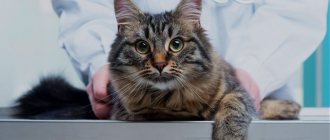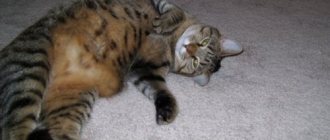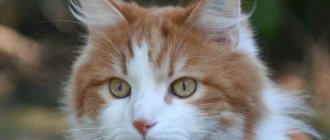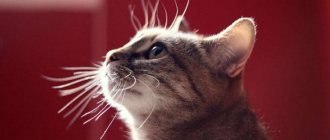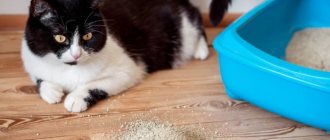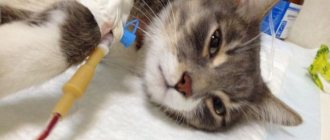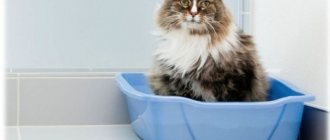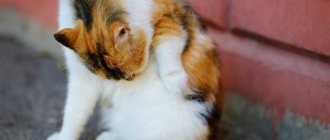Heart failure in cats is the same dangerous diagnosis as in people. The heart is the motor of the body. The deterioration of its functioning negatively affects the functioning of all organs and systems. Each owner of such a pet should know how cardiac dysfunction manifests itself in four-legged pets in order to take appropriate measures in a timely manner. What are the symptoms and treatment of heart failure in cats? How is a heart attack diagnosed and treated? What maintenance and feeding does a sick animal require? What can you do to prevent heart damage in your pet?
What is heart failure?
The heart is responsible for pumping blood; without it, no other organ can function. Heart failure (HF) is a syndrome rather than a disease. In veterinary medicine, this term means decompensated dysfunction of the myocardium (the thickest muscle of the heart, located in its middle layer, protected on the inside by the endocardium, on the outside by the epicardium and involved in pumping blood).
Some sick animals do not have pumping dysfunction, and symptoms arise due to impaired filling or emptying of the cardiac chambers of the heart. Myocardial dysfunction is initially asymptomatic and only after some time can it manifest as heart failure.
This phenomenon is considered dangerous because it is practically uncontrollable. During an attack in a calm state, there is barely enough energy to provide oxygen and vital components to organs and tissues. As soon as the cat begins to actively move, symptoms of asphyxia appear. Felines suffer from this pathology less often than humans. Most often, this syndrome is diagnosed in animals over 6 years of age, but there are cases when myocardial dysfunction manifests itself in them at an early age.
Causes
- Cardiomyopathy
- Birth defects (especially subaortic stenosis)
- Chronic valve disease
- Hyperthyroidism
- Side effect of heart medications such as digitalis
- Myocarditis
- Pancreatitis
- Low blood magnesium levels
- Acid-base disorders
- Low blood oxygen levels
The heart of animals is practically no different from the human heart and performs the same functions in the body, taking part in blood circulation processes. The only difference is the ratio of the organ relative to body weight and heart rate. The heart distills oxygen and useful substances, saturating organs, tissues, and cellular structures with it.
Important! A cat's heart beats between 100 and 140 beats per minute. In kittens this figure is slightly higher. After activity, stress, or overheating, the heart rate increases.
Failures in the functioning of the cardiovascular system, cardiac pathologies of various etiopathogenesis worsen the quality, reduce the life expectancy of animals, lead to disruption of gas exchange, the functioning of internal organs and body systems.
Causes of heart disease in cats:
- hypo-, avitaminosis;
- viral-bacterial, parasitic infections (heartworms);
- frequent stress, nervous exhaustion;
- deterioration of vascular condition;
- shunts between heart chambers;
- excessive physical activity;
- poisoning with chemicals, potent chemicals;
- genetic, hereditary predisposition;
- metabolic disorders;
- intoxication;
- chronic inflammatory processes;
- sternum injuries;
- autoimmune diseases;
- unbalanced feeding, disruption of the nutritional system, diet poor in nutrients;
- chronic respiratory diseases, endocrine pathologies;
- age-related changes in the body.
Often, pathologies, heart disease in cats, and disturbances in the functioning of the cardiovascular system in animals occur against the background of diseases and infections of various etiologies and natures. For example, one of the causes of cardiopathy can be called disturbances in the functioning of the thyroid gland. Due to the increased production of thyroid-stimulating hormone, the walls of the ventricles of the heart thicken, the volume of ejected blood decreases, which leads to the fact that the heart literally works for wear and tear.
Often, heart disease develops against the background of diabetes, obesity, and parasitic infections. Long-term use of certain medications can also lead to disruption of the heart of animals.
Regarding breed predisposition, according to statistics, Bengals, Persian, Siamese, Thai, Abyssinian, Burmese cats and their mixed breeds suffer from heart ailments of various types.
In these breeds, kittens are often born with congenital heart defects. In this case, pathologies can develop at an older age.
In some cases, the causes of heart disease are unknown, and in order to determine what caused the malfunction of the cardiovascular system, a number of diagnostic studies and measures are required.
Types of pathology
This syndrome, diagnosed in cats, is divided into many types. HF is classified into types depending on the characteristics of the pathological process, its localization, and the causes of dysfunction of the myocardium. The type of disease affects its manifestations, the choice of treatment and its outcome. Information about the types of this syndrome:
| Classification of feline heart failure | General information | |
| According to the nature of the pathological process | Chronic | It develops slowly and is stable. The disease in this form often does not manifest itself in any way due to the powerful compensatory properties of the cardiovascular system. This feature leads to the fact that owners of sick cats seek veterinary help too late. |
| Acute | It is characterized by rapid development, severe symptoms and attacks lasting from several minutes to several hours. | |
| According to the localization of the pathological process | Right ventricular | The functioning of the right ventricle of the heart is impaired. Right ventricular HF is diagnosed less frequently than left ventricular HF. |
| Left ventricular | The pathological process affects the left ventricle of the organ. | |
| Due to myocardial damage | Systolic myocardial failure | This is a general weakening of the myocardium and a decrease in contractions, developing as a result of mechanical injury, infection, the influence of drugs, intoxication of the body, electrical or thermal shock, and cancer. |
| HF due to insufficient venous blood flow | The cause of obstruction and, as a consequence, deficiency may be pressure on the heart of fluid in the pericardium or diastolic dysfunction that develops against the background of thickening of the gastric walls. | |
| HF due to high blood pressure | Appears due to prolonged and excessive stress on the heart walls during contractions. | |
| Congestive heart failure due to overload | Occurs due to certain diseases accompanied by overflow of the ventricles with blood. | |
Heart pathologies in cats
Most patients can be treated on an outpatient basis.
However, cats with electrolyte imbalances (hypokalemia or hypomagnesemia) should be temporarily hospitalized for electrolyte fluid therapy to correct the imbalance. Oxygen therapy should be given if your cat experiences hypoxia. Your veterinarian may prescribe antiarrhythmic medications for your cat, depending on the underlying cause of the ventricular premature complexes.
Even if we take into account the giants that inhabited the Earth millions of years ago - brachiosaurs, blue whales still surpass them in size, weighing more than 2 times the weight of these fossil animals. If we compare the blue whale with the second largest modern animal living on the planet, the African elephant, then the superiority of the whale is undeniable - it is 38 times heavier than the elephant.
The average length of a blue whale is 26 meters, and the largest whale ever seen by man reached a length of 33.5 meters. On average, such a whale weighs 150 tons, approximately the same as 2,400 people weigh. With all this, the heart rate of the blue whale is the slowest of all animals - during a dive it is only 4 to 8 beats per minute.
At this time, only the giant’s brain and heart are supplied with blood. By the way, its heart weighs about 650 kg and is comparable in size to a small car like a Mini Cooper. The main aorta is larger in diameter than the world's largest water pipe, located in London, and can withstand greater pressure.
And you can hear the heart of a whale working very far away - at a distance of several tens of kilometers, these sounds are easily picked up by acoustic instruments located on ships. The heart of the whale is a reliable and wear-resistant pump with high efficiency; no designer has yet succeeded in bringing such technical solutions to life.
Once upon a time, all oceans were inhabited by blue whales, but their numbers gradually decreased; in addition, whaling caused the fact that today the Arctic population of these animals numbers, according to various estimates, from several hundred to several thousand. A more accurate count is not possible given the deep-sea habitat of blue whales.
To feed itself, this giant needs to eat about 1 ton of krill every day - small crustaceans and shrimp that live in the surface waters of the ocean, which has an energy value of about 1 million calories. Swimming through layers rich in krill, whales swallow hundreds of tons of water and crustaceans, and then push out the water, straining the krill through a sieve of “baleen” - numerous horny plates hanging from the roof of their mouth.
The whale's oral cavity is a spacious room with an area of about 24 square meters. m. Whales migrate throughout the year - in the summer they “graze” in the subpolar regions of Antarctica, and by winter they move to warm equatorial waters, covering more than one thousand miles of travel. At the same time, “on the road” they may not eat anything at all, using up the fat reserves that they gained on summer or winter pastures.
Whales usually travel alone, sometimes in pairs, and can communicate by emitting intense low-frequency sounds reaching a level of 188 dB, which allows their relatives, who are located at a distance of about 1,500 km, to hear them. In a calm state, the whale swims at a speed of 10-15 km/h, but sometimes reaches speeds of up to 35-40 km/h, which, however, can be maintained for a very short time, only a few minutes.
Female whales carry their babies for 11 months, a 7-meter newborn “baby” weighing 2 tons is able to drink more than 0.5 tons of fatty mother’s milk daily and double its original weight in a week, by which time they can already provide themselves with food on their own .
The heart of pets, like the human heart, is also susceptible to various diseases. Pathologies of the cardiovascular system can be either acquired or congenital. Large Maine Coon, British and Scottish breeds, as well as Persian, Abyssinian, and Sphynx breeds have a genetic predisposition to heart defects.
READ Diarrhea in cats - causes and treatment
Many heart diseases develop gradually, often over several years. And when the animal begins to show clinical signs, the body usually already has serious disorders.
Cardiomyopathies are the most common heart pathologies in cats. The reasons for their occurrence often remain unclear.
Hypertrophic cardiomyopathy (“fat big heart”) is a major feline heart disease characterized by thickening of the heart muscle and therefore decreased ventricular volume. If detected early, this disease can be treated quite well, and improving the nutrition of the heart muscle and reducing the load on it can keep the pet healthy for many years.
Inflammatory pathologies (myocarditis and endocarditis) are of both infectious and non-infectious (aseptic) nature.
When a cat’s immune system is significantly weakened due to some kind of infection, for example, a viral one, then pathogenic bacteria (sometimes fungi) can penetrate into the lining of the heart with the blood flow and cause septic inflammation, which, without timely treatment, can result in acute heart failure.
Non-infectious inflammation of the heart muscle occurs in cats as a result of the use of certain medications (for example, cytostatics, painkillers or anti-inflammatory drugs (NSAIDs)).
Myocarditis is an inflammatory lesion of the heart muscle that occurs as a complication of sepsis, pancreatitis, panleukopenia, pyometra, uremia, and acute intoxication. Myocarditis can be acute or chronic and manifests itself in heart rhythm disturbances.
Myocardosis is a non-inflammatory heart disease characterized by dystrophic processes in the myocardium (the muscular layer of the heart). Its development is caused by unbalanced feeding, intoxication due to chronic infectious, invasive, gynecological and other non-contagious diseases.
Secondary cardiomyopathies in cats occur as a consequence of diseases of other organs, for example, with abnormalities in the thyroid gland (hyperthyroidism). Continuous tachycardia due to increased levels of thyroid hormones in the blood leads to a thickening of the wall of the left ventricle of the heart and, consequently, a decrease in the volume of ejected blood. At the same time, the heart works hard.
Congenital pathologies (cardiac arrhythmias and disorders of the heart valves) are usually associated with underdevelopment of the valvular apparatus of the heart, with disruption of the generation and conduction of nerve impulses to the myocardium, resulting in severe arrhythmias.
But severe genetic heart abnormalities in adult cats are rarely diagnosed, as they usually lead to the death of kittens at an early age.
Congenital pathologies of the heart of cats and cats: patent ductus arteriosus, narrowing (stenosis) of the pulmonary artery, stenosis of the aortic mouth.
Cardiac arrhythmias are not necessarily initially associated with diseases of the heart itself. They can occur in various diseases of other systems and organs. But with prolonged secondary arrhythmia, pathological changes will eventually appear in the heart muscle itself.
Arrhythmia (except for a congenital disorder) is not always a separate disease. To establish its cause, a number of studies are often required, since drugs prescribed for one type of rhythm disorder are contraindicated for another.
Symptoms of HF in cats
HF has quite recognizable symptoms. It depends on the age of the animal. In kittens, myocardial dysfunction is accompanied by:
- deterioration or complete loss of appetite;
- increased fatigue and lethargy, which is unusual for such young pets;
- shortness of breath and wheezing breathing;
- cyanosis of the mucous membranes (most often the tongue of kittens turns blue).
In children, the condition usually worsens in the evening. They may faint. Symptoms of HF in adult cats, in addition to those described above:
- increased thirst;
- rapid increase in body weight;
- “cordial cough”, often leading to vomiting and worsening in the evening.
It is most difficult for sick elderly pets, because they have all the symptoms of heart failure. One dull, lingering cough is worth it! The animal looks sick, plus it staggers when walking, periodically faints, and is poorly oriented in space. The most typical sign of heart problems is splayed elbows and a protruding belly.
What to do if kittens' pulses are different from normal
Some errors are considered normal in kittens' heart rate and should not cause any concern. However, a significant increase or decrease in heart rate should make the owner or breeder think about the condition of the babies.
Deviations from the normal pulse rate may indicate problems with the kitten's health. The most common of them are:
- parasites in the body (the gastrointestinal tract system most often suffers);
- tachycardia (possible during long active games);
- stressful situations;
- infectious and non-infectious diseases;
- inflammation;
- poisoning with harmful chemicals;
- hypothermia or anemia;
- skin rashes, tick bites.
Regardless of the nature of the disease, it is important to consult a veterinarian in time and establish the exact cause of the kitten’s pulse failure. If palpitations do not go away after active running or playing, this is the first sign that your pet is in pain. The same goes for a barely perceptible slow pulse.
Pulse problems in kittens are much less common than in adult and older cats. In most cases, they occur against the background of congenital characteristics, disturbances in proper growth, nutrition, or psychological stress. By maintaining a comfortable environment in the house and regularly caring for the baby, you can avoid changes in the heartbeat and maintain a normal heart rate in kittens.
Diagnostics in a veterinary clinic
At your initial appointment, you should tell your veterinarian:
- how long ago did the pet develop pathological manifestations;
- what are they expressed in;
- what is his lifestyle;
- what does he eat;
- what diseases have you suffered in the past?
- what vaccinations did he have?
After analyzing this information, the veterinarian will prescribe an examination for the four-legged patient. Information about diagnostic tests:
| Methods for diagnosing heart failure | Purpose of the event | |
| Laboratory | Clinical and biochemical blood test | Determination of the concentration of thyroid hormones and sugar |
| Instrumental | Listening to heart murmurs, detecting arrhythmias and visualizing the heartbeat | Detection of the disease in the absence of external manifestations |
| Blood pressure measurement | Exclusion of hypertension, identification of disorders in one of the blood circulation circles | |
| ECG | Detection of functional changes in the myocardium and heart rhythm disturbances | |
| Ultrasound | Detailed study of the heart | |
| Radiography | Detection of expansion of the borders of the heart, its displacement relative to the normal position, fluid in the cardiac sac, pleural and abdominal cavities | |
How to treat a cat with an enlarged heart
Most of the time, cats prefer to doze rather than sleep, that is, they are half asleep. But when a cat is actually asleep and in deep sleep, its brain produces the same waves as a sleeping person. This means that it is likely that cat dreams are similar to human dreams.
9. When the Sphynx accidentally makes eye contact with another cat, she blinks and narrows her eyes. To quickly make friends with an unfamiliar cat, catch its eye, blink, and then look away.
10. The Sphinx's pulse ranges from 160 to 240 beats per minute, depending on the age of the cat (the younger the cat, the faster its heart beats).
11. Canadian Sphynxes do not understand punishment well. It is much easier to get her to behave well if you encourage and praise her for appropriate actions.
12. Give your cat a piece of raw, boneless meat (chicken, rabbit, beef) every day. Chewing raw meat strengthens and heals cats' teeth and gums.
13. Canadian Sphynxes tolerate heat very well. They simply adore her! While basking in the sun, you take sunbathing with great pleasure!
Additional Information:
Heart diseases in cats Congenital and hereditary heart diseases Cardiomyopathy Acquired diseases Heart failure Blood clots and aneurysms Heart murmurs
The cardiovascular system of cats includes the heart itself and blood vessels - veins and arteries.
Treatment of chronic heart failure
If a cat is diagnosed with this, he will have to support his heart function for the rest of his life. Treatment is aimed at:
- improving the functioning of the myocardium and blood circulation;
- normalization of heart rate and blood pressure;
- decreased blood flow to the ventricles before contraction and the amount of fluid in the lungs, peritoneum and chest.
Treatment depends on the severity of the disease and the extent of damage to the heart muscle. Information about what medications can be prescribed to a sick pet if chronic heart failure is detected:
| Medicines | Purpose of application | |
| Diuretics | Hydrochlorothiazide, for severe chronic heart failure – Furosemide | Removing fluid from cavities |
| Angiotensin-converting enzyme inhibitors (ACEIs) | Enalapril, Captopril | Vasodilation, normalization of pressure |
| Cardiac glycosides | Digoxin | Improvement of trophism of the affected organ |
| Beta blockers | Bisoprolol, Metoprolol | Improved pumping function |
Standard treatment regimens for heart failure in cats:
- ACEI – initial stages of the pathological process;
- ACE inhibitors and diuretics – stage II or III heart failure;
- ACE inhibitors, diuretics, cardiac glycosides, beta-blockers are a typical set of drugs for the treatment of heart failure.
Symptoms and treatment of a heart attack in a cat
A heart attack (HA) in humans is usually understood as a myocardial infarction, i.e., a disturbance in the circulation of a section of the heart muscle, leading to its death. Cats don't have heart attacks. In these animals, the vessels responsible for feeding the heart are so well developed that in the event of a blockage or spasm of one of them, the blood will find a bypass route, and the heart muscle will not be left without the necessary blood circulation.
A pet has SP if it has:
- frequent and heavy (sometimes wheezing) breathing at rest, during sleep or while awake;
- no appetite;
- mucous membranes and skin have acquired a bluish tint;
- decreased body temperature and blood pressure;
- dilated pupils;
- general weakness.
In this state, animals may scream and rush around the house. The death of a cat from SP is not uncommon. To prevent this from happening, you need to take your pet to the nearest veterinary clinic as quickly as possible. If he has previously been diagnosed with heart disease, he needs to inject 0.5–1 ml of Furosemide into the muscle as quickly as possible.
With SP, the animal cannot be forcibly placed on its side. The upper part of his body should be raised so that his head is higher than his limbs. At the veterinary clinic, the four-legged patient will be injected with Furosemide into a vein, oxygen will be provided, and, if necessary, sedatives will be prescribed. In this case, medications such as Nitroglycerin, Dobutamine, Vetmedin can be used.
Cardiac cycle
The cardiac cycle is understood as successive alternations of contraction (systole) and relaxation (diastole) of the cavities of the heart, resulting in the pumping of blood from the venous to the arterial bed.
There are three phases in the cardiac cycle: 1. Atrial systole and ventricular diastole;
2. Atrial diastole and ventricular systole;
3. Total diastole of the atria and ventricles.
A cardiac impulse is the beat of the heart against the chest. It is detected by external examination of the animal and palpation on the left side of the chest. A cardiac impulse occurs due to the fact that during ventricular systole the heart tenses, becomes denser and more elastic, rises (since in the chest cavity the heart is suspended on large blood vessels), and in cats and dogs it turns slightly around its axis , hitting the chest wall with the apex (apical beat). During a clinical examination of the animal, attention is paid to the topography of the heartbeat, its strength and frequency.
Heart rate and rhythm. The contraction frequency is the number of cardiac cycles per minute. The contraction frequency can be determined by the number of heart beats, i.e. ventricular systole for 1 minute. An increase in heart rate is tachycardia, a decrease in heart rate is bradycardia.
The rhythm of cardiac activity refers to the correct coordination during cardiac cycles. Cardiac activity can be rhythmic (equal intervals) and non-rhythmic. Changes in heart rhythm are called arrhythmias. Arrhythmias can be physiological or pathological. In healthy animals, physiological arrhythmias are observed during the respiratory cycle and are called respiratory arrhythmias. Physiological arrhythmia can occur in young animals (during puberty). Both types of arrhythmia do not require special treatment.
Heart sounds are sounds that occur while the heart is beating. The main source of sound phenomena is the operation of the valve apparatus; sounds occur when the valves close. Heart sounds can be heard by applying a listening device to the chest - a stethoscope or phonendoscope. Heart sounds are heard in those places where the valves project onto the surface of the chest. These four points (based on the number of valves) are called the points of best audibility. When analyzing heart sounds, attention is paid to their topography, strength, frequency, rhythm and the presence or absence of additional pathological sounds, which are called murmurs. The study of heart sounds is the main clinical method for studying the condition of the heart valve apparatus. Atrioventricular valves close at the beginning of ventricular systole, and semilunar valves close at the beginning of ventricular diastole. There are two main heart sounds: the first (systolic), the second (diastolic).
The first sound is systolic, coincides with ventricular systole, it is low, dull, and drawn-out. The second sound is diastolic, coincides with the beginning of ventricular diastole, the sound is short, high, sonorous, abrupt. The third and fourth tones merge with the main ones when listening and therefore do not differ.
Caring for a sick animal during treatment and recovery
A sick pet requires special care. The room where it is located should be quiet. Children should be asked not to make noise or cuddle the cat. It is necessary to exclude any factor that can disturb the cat's mental balance, be it a loud vacuum cleaner, quarrels in the family, or a trip in a car. Complete rest is the key to the animal’s recovery.
The diet of a cat diagnosed with heart failure should contain:
- a minimal amount of salt, which retains water in the body, which leads to poor circulation;
- lots of taurine and protein.
Prevention of heart failure
HF is a serious syndrome. The mortality rate for cats with this diagnosis is high. Preventive measures will help reduce the risk of myocardial dysfunction in your pet. You can prevent this problem from occurring if:
- prevent the appearance of excess weight in your four-legged pet;
- give the animal rational physical activity to prevent adynamia;
- regularly show the cat to a veterinarian for timely detection of problems with the heart and other organs;
- promptly eliminate identified diseases;
- protect the cat from stress (use measures to prevent emotional shock when visiting a veterinary clinic, while traveling by car, when changing place of residence, etc.);
- feed your pet correctly (if possible, its diet should be agreed upon with a veterinarian).
Representatives of the Persian, British, Scottish breeds, Maine Coons, and Sphynx breeds, which are susceptible to heart pathologies, require special attention. When choosing a purebred kitten, it is recommended to find out whether he has any congenital diseases and whether his immediate relatives have suffered from heart disease. If the parents of the baby you like have been diagnosed with heart pathologies, it is better to refuse to buy it.
- If a cat follows you from room to room, it is believed that she is doing this in order to control your actions.
- When a cat rubs against you, it's not just out of affection. This is how she “marks” you as her territory and removes other odors from you.
- If a cat is near you and its tail is shaking, this is the highest degree of love that it can express.
- If a cat brings you prey, such as a mouse, then it is showing concern for you and wants to feed you. Here it is important not to scold the cat for the “gift”, but to praise the fluffy one.
- If your cat constantly scratches the furniture, then spray the area with citrus juice. Cats can't stand this smell.
- Not all cats are afraid of water. So, a Turkish Van cat loves to swim.
- Grooming calms cats and neutralizes their aggressiveness. If a cat doesn't know which path to take or what's best to do, she may stop and start licking herself - this is how she thinks about her decision.
- If a cat is attacked, it will press its ears tightly against its head. This is how she instinctively defends herself from the teeth and claws of the enemy. If the cat attacks itself, then it lowers its ears horizontally and to the sides, forming a threatening triangle.
- Cats have healing abilities. In folk medicine there is even a special feline therapy - a method of preventing and treating various diseases through contact with cats.
- It is believed that cat owners have a 30% reduction in the likelihood of a heart attack or stroke.
- Cats spend almost their entire lives sleeping. So, out of 9 years lived, your cat will sleep through 6 years.
- A cat can jump to a height 5 times its height.
- Cats can turn their ears 180 degrees because their outer ear is controlled by as many as 32 muscles. For comparison, a person has only 6 such muscles.
- Cats have 24 more bones than humans. This explains their natural plasticity. However, cats do not have collarbones, which allows them to fit into small holes that their heads fit into.
- Cats' heart beats almost twice as fast as humans' (110-140 beats per minute), and their body temperature is about 38 degrees.
- Each cat's "nose print" is as unique as a person's fingerprint.
Prevention
Cats suffering from heart failure need preventative care to keep them active. We need to try to “stir up” animals that lead a “sofa” lifestyle. Obese cats are at risk for heart disease. You need to ensure your pet is eating properly. An annual checkup with a veterinarian will protect him from heart disease.
Sphynx, British, Persian, Scottish cats, and Maine Coons are also susceptible to heart disease. This does not mean that all cats of these breeds, sooner or later, have heart problems. This statement means that representatives of these breeds develop heart disease at an earlier age.
Heart failure in neutered cats is quite common because these animals are very lazy. They lead a sedentary lifestyle and are obese.
It is necessary to pay increased attention to neutered cats, as they are more susceptible to heart disease.
A diagnosis of heart failure in cats is not a death sentence. The main thing is to notice the first symptoms of the disease in time, carry out regular examination and treatment. Monitor your pet's diet. With proper care and care, a cat can delight its owner with affection and beauty for a long time.
Description
To pump blood to the lungs and body, the heart must work in harmony. The heart has an electrical conduction system that is responsible for controlling heart rate. This electrical conduction system generates electrical impulses (waves) that travel throughout the musculature of the heart, stimulating the heart muscles to contract and push blood through the internal arteries into the body. There are two nodes in the heart that play an important role in this conduction system.
The sinus node is a cluster of similar cells located in the right atrium.
Its purpose is to generate electrical impulses and serve as a pacemaker. The other node is called the atrioventricular node. Like the sinus node, it is a clustered collection of similar cells located in the right atrium. The atrioventicular node receives impulses from the sinus node and, after a short delay, sends impulses to the ventricles. This delay allows the atrium to pump blood into the ventricle before the ventricular muscles contract.
Diagnostics
Your veterinarian will conduct a thorough physical examination of your cat, taking into account the history of symptoms and possible incidents that may have led to this condition. A complete blood count will be performed, including a blood chemistry panel, complete blood count, urinalysis, and electrolyte panel. The electrolyte panel will show whether there is hypokalemia and hypomagnesemia. The blood test will also show signs of pancreatitis and hyperthyroidism, if any.
A cardiac echocardiogram should be performed to check for structural heart disease. Long-term ambulatory (Holter) ECG recordings may be done to detect transient ventricular arrhythmias in patients with unexplained syncope or weakness.
Forecast
The prognosis is uncertain and depends on whether the underlying cause can be eliminated. Remember that the arrhythmia may worsen and/or fainting or sudden death may occur. If there is a structural heart disorder (which your veterinarian will tell you about) or if your cat is showing clinical signs of arrhythmia, you will need to limit its activity. Your doctor will schedule follow-up appointments as needed to treat your underlying condition.
Similar articles
Pets have an organism no less complex than their owners, and their heart disease…
A slower than normal rate of impulses in a cat's sinus node is medically called...
Distemper in cats The parasite species Yersinia pestis causes a bacterial disease called distemper. This condition occurs in cats...
Sometimes cats breathe with their mouths open, just like dogs. It’s unusual to see this “trick” performed by a domestic cat, and many owners begin to worry: is everything okay with their pet or is it time to run to the vet?
We hasten to reassure you: in most cases, breathing through a cat’s mouth is absolutely normal. But there are situations when this can be a wake-up call.
Let's talk about everything in order.
Simple physiology: when a cat’s mouth breathing is normal
- When the animal has had enough of playing. The cat was running around actively and a lot, and then stopped with its mouth slightly open? Everything is fine!
- When the animal made a forced march through the apartment. And again, a pet that has played enough just needs to “catch its breath.”
- When the cat is hot. Sometimes the house gets a little hot, and in this way the animal regulates heat exchange.
- When the animal is scared or stressed.
- When a cat gives birth.
Usually at such moments the cat breathes through its mouth for a short time - breathing quickly returns to normal. Exceptions are overheating and childbirth.
If you notice that the cat did not play or run, the house is cool, there was no stress with the pet, and he is definitely not giving birth, but is breathing through his mouth, then you should worry.
Pathologies: when a cat's mouth breathing is a sign of illness
- Something happened to the lungs.
- Something happened to the nasopharynx.
- Something happened to the cardiovascular system.
- The cat is in severe pain due to the injury.
- The cat has an allergic reaction, breathing with its mouth is a sign of Quincke's edema.
- The cat was poisoned.
The most careful attention should be paid to Maine Coons, Britons and Sphynx cats, overweight and middle-aged cats, and animals with chronic diseases. In such cases, sudden and inexplicable mouth breathing is a reason to immediately go to the veterinarian.
There is no first veterinary care for shortness of breath, because it is only a symptom. All you can do is call a veterinarian at home or go to the clinic. Do not try to give the animal artificial respiration, do not give human medicine, do not shake the pet by the scruff of the neck, do not try to force it to drink. Perhaps, after examination and diagnosis, the doctor will tell you how to stop the attacks.
The cat's pulse is below normal
Tachycardia or rapid pulse is a dangerous disease. What if the cat’s pulse is below normal? This is also bad: bradycardia
(low pulse) leads to severe weakness, the formation of blood clots, with this disease the internal organs are poorly supplied with blood and quickly fail. In addition, this is also dangerous, since with bradycardia, animals often lose consciousness.
Sometimes bradycardia is accompanied only by weakness, but in advanced cases the following symptoms may be present:
- Impaired coordination of movements (the cat has a “drunk” gait);
- Fainting;
- Arrhythmia;
- Periodic seizures;
- Jumps in blood pressure (normally, a cat’s blood pressure ranges from 105/65 to 135/95 mm Hg);
- Labored breathing.
Bradycardia in a cat is not an independent disease. This is a symptom of other serious illnesses:
- Poisoning (insect and snake poisons, lead, pesticides, etc.);
- Heart problems (myocarditis, cardiomyopathy, aortic stenosis, etc.);
- Sepsis in infectious diseases or as a complication after surgery;
- Hypothermia;
- High intracranial pressure due to traumatic brain injury and brain diseases (meningoencephalitis, meningitis, epilepsy, etc.);
- Heavy bleeding;
- Hypothyroidism;
- Anemia;
- Constant stress;
- Overdose of cardiac drugs.
It is possible to rid a cat of bradycardia if the cause of the low pulse is determined. To make a correct diagnosis, the doctor will prescribe urine and blood tests, as well as important studies: ultrasound and x-ray of the heart, as well as an electrocardiogram.
